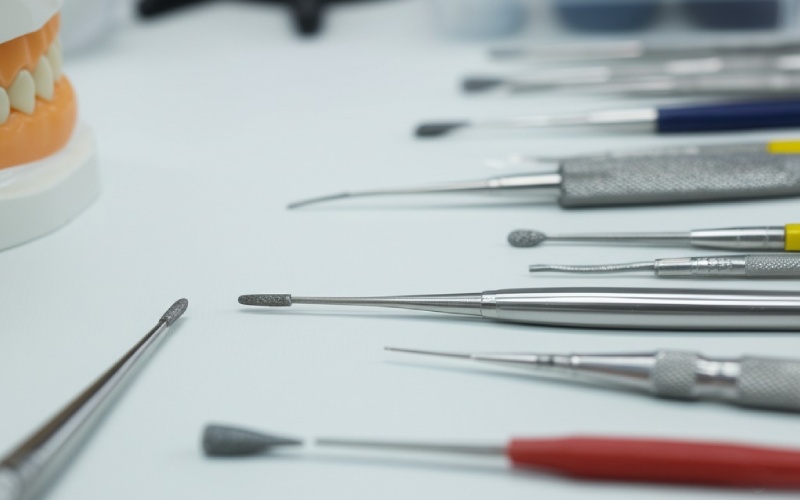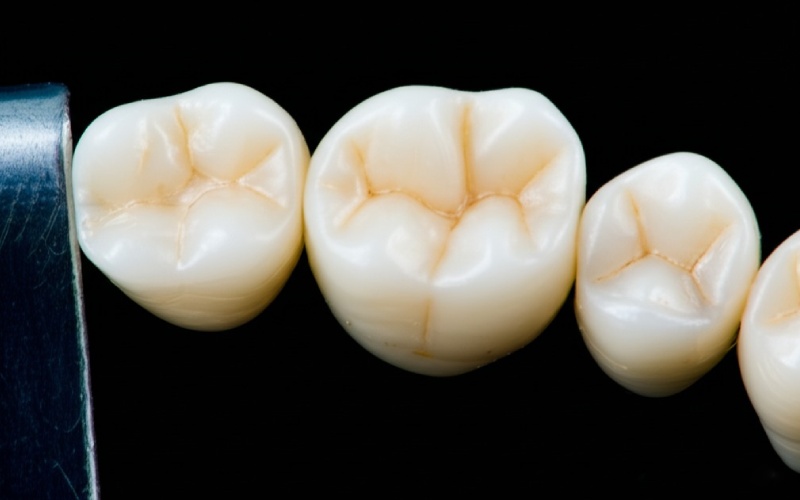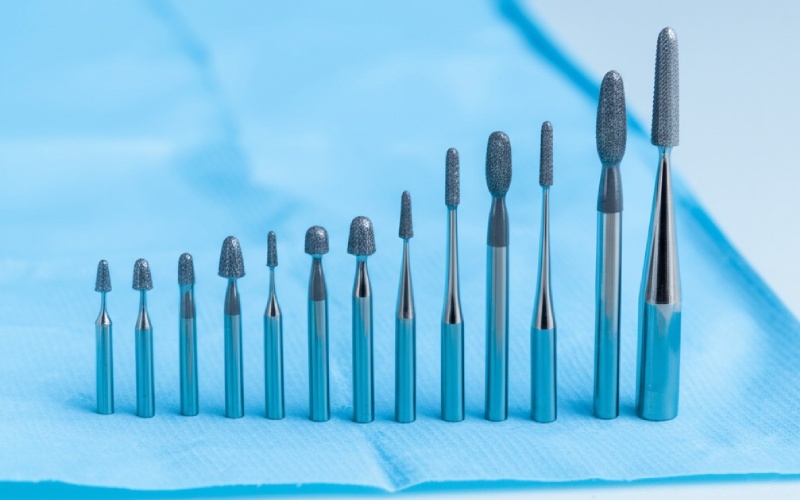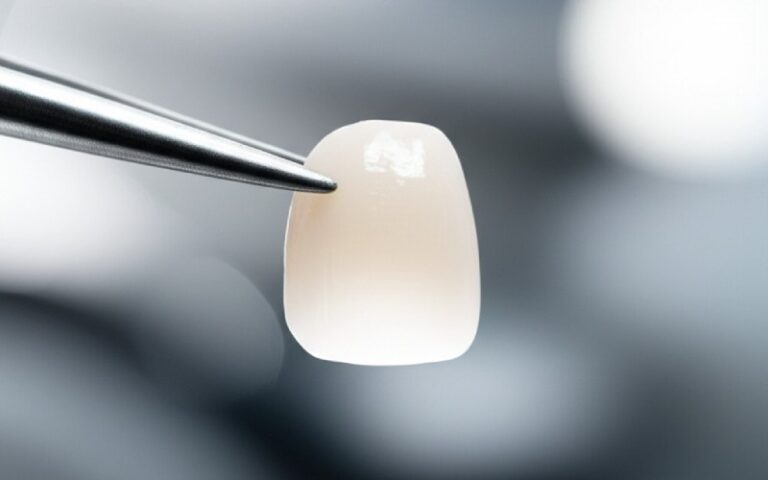
Ultimative retningslinjer for tandpræparation til porcelænsfusede metalkroner
The PFM crown, or porcelain-fused-to-metal crown, is a true classic. Getting the tooth preparation right is the most important step for a successful PFM-krone. If the prep is wrong, the crown will not fit well. It might not look good or last long. In this article, I will share the steps to make sure every PFM crown that is placed is a success. This guide will help you create a great foundation for a long-lasting restoration.
Indholdsfortegnelse
What Is a PFM Crown, and Why Do We Still Use It?
Think of it as a hybrid. It has a strong metal base, or metal substructure, that fits over the prepared tooth. Then, a skilled ceramist covers this metal with layers of beautiful porcelain. This combination of strength and beauty is why the PFM crown has been a go-to dental restoration for so long. The metal provides amazing durability, and the porcelain gives it the look of a natural tooth. It is a time-tested solution for full-coverage restorations.
Even with new materials like zirconia, the PFM crown still has a big place in modern dental care. Why? Because it works, and it works very well. These crowns provide a predictable result. They are also very strong, making them great for back teeth that handle a lot of chewing force. Their ability to combine strength with good looks makes them a popular choice for many dental cases.
These PFM restorations can last for a very long time. It is not uncommon for a well-made PFM crown to last 15 to 20 years with good hygiene. This durability comes from the metal inside. This metal can be made from different materials, including base metal alloys. The success of the PFM crown starts with a proper tooth preparation. A good prep makes sure there is enough space for both the metal and the porcelain. This is why following clear preparation guidelines is so important for every single tooth.
What Are the Main Advantages and Disadvantages of a PFM Restoration?
When choose a type of restorative material for a patient, you should always think about the pros and cons. The PFM crown has many advantages. The biggest one is its strength. The metal substructure makes the PFM crown very tough and resistant to breaking. This makes it a great choice for a tooth anywhere in the mouth, whether it is an anterior or posterior tooth. Another plus is the excellent fit. Dental restorations made with metal have a long history of fitting the prepared tooth very well. This tight fit helps protect the underlying tooth from decay.
Of course, there are some disadvantages and disadvantages to think about. The main challenge with a PFM crown is aesthetics. Because it has a metal core, it can prevent light from passing through the way a natural tooth does. This means it lacks the translucency of all-ceramic crowns. Sometimes, a dark metal margin can show at the gum line, especially if the gum tissue recedes over time. This is a key reason some patients prefer other options for their front teeth.
Another point to consider is the tooth reduction needed. To make room for both metal and porcelain, a dentist has to remove a good amount of the tooth structure. A PFM crown prep requires more tooth reduction than some other crown types. This is needed to create enough space for the materials. If not enough of the tooth is removed, the final PFM crown might look bulky or the porcelain might be too thin and weak. Any dentist must balance these factors when planning for a new PFM crown.

How Much Tooth Reduction Does a PFM Crown Prep Require?
This is a very important question. Creating enough space for the PFM crown is the whole point of the preparation. If you don’t remove enough of the tooth, the Dentallaboratorium can’t make the crown strong or pretty. The PFM crown prep dimensions are specific. You need to account for the thickness of both the metal and the porcelain. For the surfaces covered in porcelain, you generally need about 1.5 to 2.0 millimeters of reduction. This gives the ceramist room to build up porcelain for good aesthetics.
On the other hand, some surfaces might not need as much reduction. For example, you might design a PFM crown with a metal occlusal surface for a back tooth. These crowns with a metal occlusal need less reduction on the top chewing surface, maybe only 1.0 to 1.5 millimeters. This can help save more of the natural tooth structure.
The goal of proper tooth preparation is to create a smaller version of the tooth that the final PFM crown can slide over smoothly. This means the walls of the prepared tooth should be slightly tapered. A taper of about 6 to 10 degrees allows the restoration to seat fully without being too loose. Getting the tooth reduction right is a skill that takes practice, but it is essential for any long-lasting PFM crown. This is the first step toward a successful dental treatment.
What Is the Best Margin Design for PFM Crowns?
The margin is where the crown meets the tooth. This is a critical area. A bad margin can lead to several problems, like decay, gum tissue irritation, and the PFM crown failing. For PFM crowns, many prefer margin design is a combination. The shoulder on the cheek side gives the dental lab plenty of room for the porcelain. This helps achieve the best aesthetics and hide the metal edge.
The shoulder margin on the labial or buccal side should be about 1.2 to 1.5 millimeters wide. This is what we call a buccal shoulder. It creates a clear finishing line for the lab technician and supports the porcelain layer. On the tongue side, a chamfer margin is usually enough. The chamfer is a gentler slope and requires less tooth removal. This is good because the aesthetics are not as important on that side of the tooth. This combination of a chamfer and a buccal shoulder is a classic approach for a PFM crown.
A well-defined margin is also important for periodontal health. A smooth, clear margin is easier for the patient to clean. This helps prevent plaque buildup around the PFM crown and keeps the gum tissue healthy. A poor margin can cause recession, which is when the gums pull away from the tooth. This can expose the metal margin of the crown, which doesn’t look good. Taking the time to create a perfect margin is a crucial part of the pfm crown preparation.
How Do You Prepare Anterior Teeth for PFM Crowns?
When you are working on anterior teeth, or front teeth, aesthetics are everything. The patient wants their new PFM crown to look just like their surrounding teeth. This means your tooth preparation must be perfect. For anterior PFM crowns, you need to be very careful with the labial reduction. You must prepare the labial surface in two planes to follow the natural shape of the tooth. This ensures the final crown does not look too thick or flat.
The incisal edge, or biting edge, of the tooth also needs enough reduction. 2.0 millimeters of incisal reduction can give the ceramist enough room to create a natural-looking incisal edge with some translucency. If you don’t reduce the incisal edge enough, the porcelain will be thin and grey, showing the metal underneath. A PFM crown on a front tooth needs this extra attention to detail to look its best. This is a very important part of placing PFM crowns on anterior teeth.
Another key for a great anterior PFM crown is communication with your dental laboratory. You need to tell them what you want. Take a good shade and send photos of the tooth and the nearby teeth. This helps the ceramist to create a crown with good color and shape. Your detailed tooth preparation for pfm crowns gives them the canvas they need to create a work of art. The success of an anterior PFM crown is a team effort between the dentist and the lab technician.
Are the Preparation Guidelines Different for Posterior Teeth?
Yes, the preparation guidelines for pfm are a bit different for posterior teeth, or back teeth. With posterior teeth, strength is more important than perfect aesthetics. These teeth do all the heavy chewing, so the PFM crown needs to be strong. This means you might choose a different design for the PFM restoration. For example, a PFM crown with a full metal occlusal surface is a very strong and long-lasting choice for a molar.
When you prepare a tooth for a PFM crown with a metal occlusal, you don’t need to remove as much tooth structure from the chewing surface. These crowns need less reduction, maybe 1.0 to 1.5 millimeters, because you don’t have to make room for porcelain on top. This is a great way to save more of the healthy tooth. The margin design can also be simpler. A chamfer margin all the way around the tooth is often fine for a posterior PFM crown.
Even though aesthetics are less of a concern, you still need a precise PFM crown prep. You must ensure there is enough reduction on the buccal side for the porcelain layer. You still need to follow the long axis of the tooth to ensure the crown will draw properly. A good PFM crown on a posterior tooth can provide years of trouble-free service. It is a very reliable dental solution for restoring a damaged back tooth.
What Is the Role of the Dental Laboratory in PFM Crown Success?
The dental laboratory is your partner in creating a great PFM crown. Your job is the proper tooth preparation. Their job is to use that prep to build a beautiful and functional restoration. A good relationship with your dental lab is priceless. When knowledgeable dental lab technicians get a good impression of a well-done PFM crown prep, they can do amazing work. The fit and aesthetics of the final crown depend on their skill.
A modern dental laboratory offers many options. They use advanced dental technology and materials. When they receive your case for a PFM crown, the first thing they do is inspect your prep work. They look for sharp angles, undercuts, and a clear margin. A good prep makes their job easier and leads to a better PFM crown. A bad prep can lead to a crown that doesn’t fit, has poor contacts, or bad color.
Communication is key. The lab needs to know what you want. Do you want a full porcelain wrap or a metal contact area? Do you have any special requests for the aesthetics? The more information you give them, the better the final PFM crown will be. The ceramist needs to know the shade, but also things about the character of the tooth. Your prescription is a vital link. A skilled ceramist can use your prep to make a tooth that is both strong and beautiful.
How Do PFM Crowns Compare to Newer Zirconia Crowns?
This is a common question in the dental world today. Zirconia crowns have become very popular. Zirconia is a very strong, tooth-colored ceramic material. So how do they stack up against the classic PFM crown? Zirconia crowns have a big advantage in aesthetics. Because they are all-ceramic, they have great translucency and refractive properties. They look very much like natural teeth. There is no metal inside to block light or cause a dark line at the gum.
However, the PFM crown still has some benefits. One is the way they are bonded to the tooth. PFM crowns can be cemented with traditional dental cements, which have a very long track record of success. Some zirconia crowns require special bonding techniques. Also, while zirconia is strong, it can be very hard. Some dentists worry that it can wear down the opposing natural tooth over time. A PFM crown with a porcelain surface is generally kinder to the opposing teeth.
The choice between a PFM crown and a zirconia crown depends on the case. For a front tooth where looks are the top priority, zirconia is often the best choice. But for a back tooth on a patient who grinds their teeth, the durability of a PFM crown with a metal occlusal is hard to beat. Both are great dental restorations. The key is to know when to use each one. A PFM crown remains a solid, reliable, and cost-effective choice.
Can You Avoid the Dark Line at the Gum with a PFM Crown?
That dark line is the biggest aesthetic complaint about the PFM crown. It happens when the metal edge of the crown becomes visible right at the gum line. This can happen right away if the margin is not hidden well, or it can happen over time if the patient has gum recession. It’s a real concern, especially for a tooth that shows when the patient smiles. But yes, there are ways to avoid it.
The best way is with a porcelain butt margin. This means the lab makes the labial margin of the crown entirely out of porcelain, with no metal at the very edge. To do this, you need to prepare a deeper shoulder margin, about 1.5 mm. This gives the lab enough room to hide the metal substructure higher up and create a porcelain-only edge. This technique dramatically improves the aesthetics of a PFM crown and is a standard for any anterior tooth.
Other options include crowns with conventional metal collars that are very thin and polished. But the porcelain margin is the best solution. Good oral hygiene is also key. Teaching your patient how to keep the area around their PFM crown clean will help keep the gum tissue healthy. Healthy gums are less likely to have recession, which means the margin of the tooth restoration stays hidden. A well-made PFM crown on a well-prepared tooth should not have a visible dark line.

What Are the Key Steps for Delivery and Cementation?
Your perfect PFM crown prep is done, and the beautiful PFM crown is back from the lab. Now it’s time for the final step: delivery and cementation. First, try the crown on the tooth without any cement. Check the fit. Does it seat all the way? Use an explorer to check the margin. It should be smooth with no gaps or ledges. Check the contacts with the neighboring teeth using floss. The floss should snap through with a nice, firm feel.
Next, check the bite, or occlusion. Have the patient bite down on marking paper. Look for high spots. The new PFM crown should not hit harder than the other teeth. If there are high spots on the porcelain, you can adjust them carefully with a fine diamond bur and then polish the area until it is smooth again. Do not skip this polishing step. Rough porcelain can wear down the opposing tooth.
Once you are happy with the fit, contacts, and bite, you are ready to cement the PFM crown. Clean and dry the inside of the crown and the prepared tooth. Mix your chosen dental cement according to the instructions and apply a thin layer inside the crown. Seat the PFM crown firmly on the tooth and have the patient bite down on a cotton roll. After the cement sets, clean up all the excess from around the margin. Taking care with these final steps ensures your beautiful restoration will be comfortable and long-lasting.
Ting at huske på
- A PFM-krone combines the strength of metal with the aesthetics of porcelain.
- Korrekt tandpræparation is the most critical step for success.
- For en PFM-krone, you need 1.5-2.0 mm of reduction on porcelain surfaces to create enough space.
- Brug en buccal shoulder margin for good aesthetics on the front of the tooth.
- Prepare anterior teeth in two labial planes to create a natural-looking restoration.
- For Bageste tænder, a PFM crown with a Okklusal overflade af metal is a very strong and durable option.
- A good relationship and clear communication with your Dentallaboratorium are essential.
- You can avoid a dark line at the gum by requesting a porcelæn butt margin from your lab.
- Always check the fit, contacts, and bite before the final delivery and cementation of the PFM crown.




